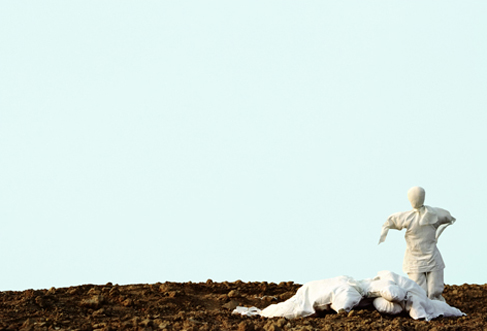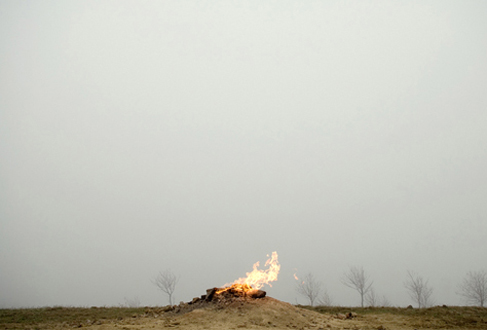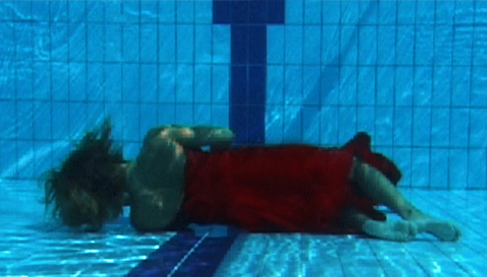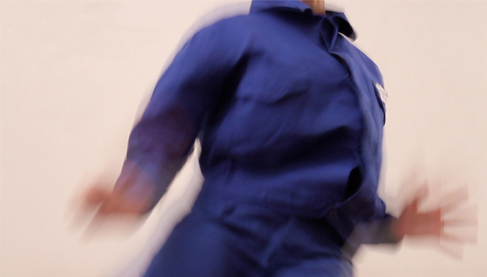|

SILVIA CAMPORESI
THE FULL MOON IS SOMETHING PERFECT WHICH
THE VERY NEXT DAY WILL NO LONGER BE VISIBLE
04.09 / 07.12.2010
“The full moon is something perfect which the very next day will no longer be visible” was originally a fragment of text, an excerpt written by the French philosopher Simone Weil which shows a deep connection between text and image, something that is directly connected to your artistic research and evolution. How did you transform Simone Weil’s inspiration in this open series of photographs?
I have been reading Simone Weil’s ‘Cahiers’ for years and I have always considered them as an open work, every time that I have the chance to read them I find new interpretations and inspirations.
All my work has strong references to other kind of arts, there’s a fundamental origin which I can’t disregard. In this case fragility's beauty and perfection, the recognition that in “every beauty there’s death” is the topic of the series. The topics discussed in Simone Weil’s Cahiers are several but, i believe that they can all be traced back to the vertiginous idea of overcoming a limit: the spiritual evil limit, the gravity limit, the human condition limit compared to the mathematic and divine infinity.
In her pages I find a flash of inspiration, visions of images: “La luna piena è una cosa perfetta che già il giorno dopo non si rivedrà più” was born in this way. A perfect full moon surrounded by landscapes and human figures ‘locked’ in the landscape. I found beauty in melancholic shades of the fog, in desolated landscapes, in small objects full of affection or in a underwater ‘interior castle’ (a quote by Teresa D’Avila’s work, often mentioned in Simone Weil’s Cahiers). Each image has a tight, even though not immediate, connection with Simone Weil’s words, it is part of the path, it is the end of the circle. This series, initially started with twenty photographs, is open as I intended the Cahiers. It will be expanded after each further reading .
The "Dance Dance Dance" video was created from a quote by Murakami Haruki, a Japanese writer. The dance is intended as a vital movement of "a human being in his own destiny", an inexhaustible action that takes place in a pool, in the water.
The idea of “Dance Dance Dance” was born in the summer, while swimming in a pool. A personal challenge which consisted of several hours of training every week. This unremitting swimming made me think of Murakami Haruki’s “Dance Dance Dance”, a contemporary novel with a traditional structure: the main character lives weird experiences that lead him to a state of superior awareness, a path marked by the encounter of a sage that reminds him to “…dance, continue to dance until there will be music. To keep dancing, step after step”. A warning that recalled me of another book, “Tales of a Russian pilgrim”, in which the warning is to continuously pray. In both situations the meaning of repetition is evolution, a spiritual rise. Thinking over both novels made me naturally choose to substitute dancing with swimming and the pilgrim's prayers suggested me the "vision" of the cross. In pools crosses are along the edges to indicate where to turn but, in my physical and spiritual movement, I saw the cross with the eyes of the pilgrim. Swimming as a holy dance, every turn increases the spiritual strength.
It is easy to notice a strong connection between “Dance Dance Dance” and “Secondo Vento”. The spiritual rising reachable through the repetition of elegant and harmonic movements (in this case martial arts) is amplified by the idea of shooting the video in a prison’s cell and by the references to Kim Ki-duk’s film “Bin-Jip”.
Kim Ki-duk’s “Bin-Jip” is the starting point of “Secondo Vento”. Quite often it is possible to find direct references to movies and novels in my works. The setting and the attempt to overcome the limit of an enclosed space are the similarities. Kim Ki-duk’s character becomes invisible to his guard, redeeming his essence, but in my work both the meaning and the end are different. The feminine figure – a European karate champion – becomes aware of the enclosed space through a series of movements (the superior kata Unsu) until the final jump allows her to escape form the cell (here intended as the limit). A Simone Weil’s excerpt enhance the idea: “don’t fight gravity with actions but with thoughts, loving the ascending direction”. The title “Secondo Vento” is taken by Gurdjeff's theory which defines the second wind as the most powerful energy that we are left with once the ‘normal’ one is exhausted. The video's audio is a song sang by me and turned upside down: it gives an undefined holy atmosphere to the video, without being recognizable as part of any known religions.
Your videos' main characters always seem to transcend the reality that you re-create around them in order to become timeless and symbolic figures like the volcano shot in “Breve Storia dell’Infinito” or the “Materia Prima” dream inspired by the Ponte della Signora’s legend. I always try to transcend the space-time dimension. It’s important not to know in which year, place or during which historical-political events I shoot my videos. I choose a timeless present and a space with no connotations, because symbolism is the only dimension which I care about. The fire of “Breve storia dell’infinito” is a way to represent the infinite, a symbol suggested by our finished human condition. That apparently simple fire, is the smallest European volcano and it has been burning uninterruptedly for 500 years. A perpetual flame that encloses several meanings. The video is a still shot of the volcano passing from day to night and viceversa. “Materiaprima” was born in a small village in Romagna: I’ve work on an old legend about a XVIII century’s lady that wanted a bridge to be able to ride her horse through-out her land. One night the lady died falling of her horse while she was crossing the bridge: I worked on all the key elements of this legend and I re-read them as if they were part of a dream.
You participate in your works in a physical way, with the voice that you gave to the “Secondo Vento” melody with your presence in some images of “La luna piena e’ qualcosa di perfetto che gia’ il giorno dopo non si rivedra’ piu’” and in some of your most relevant projects: a path that begins with “Ophelia” (2004) through “Morphing” (2007) until “Eravamo persone come alberi” (2010). You play a fundamental role in the development of the images through different levels of identification.
I often become part of my work by playing the characters that I stage. It started as a game but now it is a conscious decision and often a necessity, even if it’s not a rule (like in Cindy Sherman’s work for instance). The mentioned works are part of personal reflections which developed even before the artistic project: they evolve as autobiographical matters and it will make no sense to have someone else but me to interpret them. The five self portraits of “Eravamo persone come alberi” are a perfect example: I chose five women on the edge of mysticism and madness and I interpreted them by dressing-up. The meaning of this work lies in going from one identity to the other, by using a regular procedure. The meaning of these changes coincide with my personal development: I become what I went through.


Biography
Born 1973 in Forlì (IT).
Lives and works in Italy
Website: www.silviacamporesi.it


On Screening:
Dance Dance Dance (dvd, 4’31”, 2007 )
Secondo Vento (dvd, 3’45”, 2010)
Selected Films:
Rosencrantz and Guildenstern are dead (Tom Stoppard 1990)
Mulholland Drive (David Lynch 2001)
Bin-jip (Kim Ki Duk 2003)
---
Curated by Marco Nember
Developed in collaboration with
the Italian Institute of Culture in
Amsterdam between May 2009
and September 2013
|